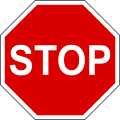
Road signs in Mauritius are standardised traffic signs used in Mauritius according to the Traffic Signs Regulations 1990 (French: Règlement sur la Signalisation Routière 1990). They are heavily modelled on road signs in the United Kingdom, since Mauritius is a former British colony and drives on the left.
Signing system
The traffic sign are divided into three classes; circles gives orders, triangles warns of possible dangers and rectangles gives information. Different colours are use within these shapes; blue circles are mandatory signs, it gives positive instructions, while red circles are prohibitory signs, it give negative instructions. Blue rectangles give general information while green rectangles are use for direction sign on main roads. However, there are three exception for these shapes and colour rules; that is the octagonal Stop sign, the diamond priority road sign and the inverted red triangle Give way sign.
Warning signs
Warning signs indicates a hazard ahead on the road that may not be readily apparent to a driver.
-
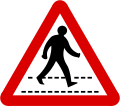 Pedestrian crossing ahead
Pedestrian crossing ahead
-
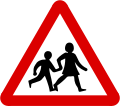 Children
Children
-
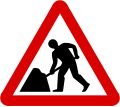 Roadworks
Roadworks
-
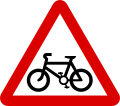 Cyclists
Cyclists
-
 Domestic animals
Domestic animals
-
 Wild animals
Wild animals
-
 Slippery road
Slippery road
-
 Loose gravel
Loose gravel
-
 Falling rocks
Falling rocks
-
 Hump bridge
Hump bridge
-
 Hump
Hump
-
 Uneven surface
Uneven surface
-
 Quay or riverbank
Quay or riverbank
-
 Steep ascent
Steep ascent
-
 Steep descent
Steep descent
-
 Low-flying aircraft
Low-flying aircraft
-
 Crosswinds
Crosswinds
-
 Ungated level crossing
Ungated level crossing
-
 Gated level crossing
Gated level crossing
-
 Other dangers nearby
Other dangers nearby
-
 Traffic signals ahead
Traffic signals ahead
-
 Roundabout ahead
Roundabout ahead
-
 Two-way traffic across one-way road
Two-way traffic across one-way road
-
 Two-way traffic ahead
Two-way traffic ahead
-
 Road narrows on right side
Road narrows on right side
-
 Road narrows on both sides
Road narrows on both sides
-
 Right-hand lane of a 2-lane 1-way road closed
Right-hand lane of a 2-lane 1-way road closed
-
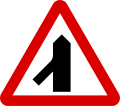 Traffic merging from the left
Traffic merging from the left
-
 Crossroad
Crossroad
-
 Side road (right)
Side road (right)
-
 Staggered junction
Staggered junction
-
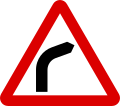 Curve to the right
Curve to the right
-
 Double curve to the right
Double curve to the right
-
 Chevrons
Chevrons
Priority signs
Priority signs are intended to instruct road users on what they must or should do (or not do) under a given set of circumstances.
Prohibitiory signs
Prohibitory signs are used to prohibit certain types of manoeuvres or some types of traffic. The No symbol surrounding a pictogram is used to indicate something that is not permitted.
-
 Temporary closure of road - Go
Temporary closure of road - Go
-
 Temporary closure of road - Stop
Temporary closure of road - Stop
-
 No left turn
No left turn
-
 No right turn
No right turn
-
 No U-turns
No U-turns
-
 Prohibition of passing without stopping
Prohibition of passing without stopping
-
 Prohibition of passing without stopping - Police
Prohibition of passing without stopping - Police
-
 Prohibition of passing without stopping - Customs
Prohibition of passing without stopping - Customs
-
 Prohibition of passing without stopping - Children
Prohibition of passing without stopping - Children
-
 No overtaking
No overtaking
-
 No overtaking
No overtaking
-
 No vehicles - Vehicular traffic prohibited in both directions
No vehicles - Vehicular traffic prohibited in both directions
-
 No entry - Prohibition and restriction of entry
No entry - Prohibition and restriction of entry
-
 No entry for pedestrians
No entry for pedestrians
-
 No cyclists
No cyclists
-
 No entry for handcarts
No entry for handcarts
-
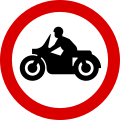 No entry for motorcycles
No entry for motorcycles
-
 No entry for power driven vehicle except two-wheeled motorcycles without side-car
No entry for power driven vehicle except two-wheeled motorcycles without side-car
-
 No entry for power-driven agricultural vehicles (Tractors)
No entry for power-driven agricultural vehicles (Tractors)
-
 No entry for buses and coaches
No entry for buses and coaches
-
 No entry for goods vehicles
No entry for goods vehicles
-
 Axle weight limit
Axle weight limit
-
 No entry for vehicles having an overall height exceeding 3.5 metres
No entry for vehicles having an overall height exceeding 3.5 metres
-
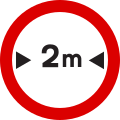 No entry for vehicles more than 2 metres wide
No entry for vehicles more than 2 metres wide
-
 No entry for vehicles exceeding 10 meters in length
No entry for vehicles exceeding 10 meters in length
-
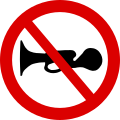 Prohibition of audible
Prohibition of audible
-
 Maximum speed limit (50 km/h)
Maximum speed limit (50 km/h)
-
 End of all prohibitions
End of all prohibitions
-
 Speed limit zone
Speed limit zone
-
 Parking prohibited
Parking prohibited
-
 Parking and standing prohibited (Clearway)
Parking and standing prohibited (Clearway)
Mandatory signs
Mandatory signs are used to set the obligations of all traffic which use a specific area of road. Unlike prohibitory or restrictive signs, mandatory signs tell traffic what it must do, rather than must not do.
-
 Pass on the left
Pass on the left
-
 Pass on the right
Pass on the right
-
 Pass either side
Pass either side
-
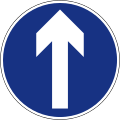 Ahead only (turning left and right is prohibited)
Ahead only (turning left and right is prohibited)
-
 Vehicular traffic must turn to the left ahead
Vehicular traffic must turn to the left ahead
-
 Vehicular traffic must turn to the right ahead
Vehicular traffic must turn to the right ahead
-
 Left turn only
Left turn only
-
 Right turn only
Right turn only
-
 Roundabout - Vehicles entering the junction must give way to traffic to vehicles coming from the right
Roundabout - Vehicles entering the junction must give way to traffic to vehicles coming from the right
-
 Compulsory footpath
Compulsory footpath
-
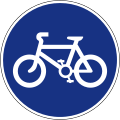 Compulsory route for bicycles
Compulsory route for bicycles
-
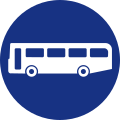 Compulsory route for buses
Compulsory route for buses
-
 Minimum speed limit (30 Km/h)
Minimum speed limit (30 Km/h)
-
 End of minimum speed limit (30 Km/h)
End of minimum speed limit (30 Km/h)
Information signs
Information signs informs people.
-
 Hump
Hump
-
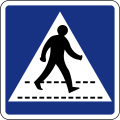 Pedestrian crossing
Pedestrian crossing
-
 One-way traffic
One-way traffic
-
 No through road
No through road
-
 No through road to the right
No through road to the right
-
 No through road to the left
No through road to the left
-
 In
In
-
 Out
Out
-
 No entry
No entry
-
 No exit
No exit
-
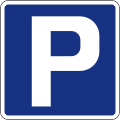 Parking
Parking
-
 Hospital
Hospital
-
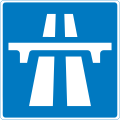 Sign notifying an entry to a motorway
Sign notifying an entry to a motorway
-
 Sign notifying an exit from a motorway
Sign notifying an exit from a motorway
-
 Dual carriageway
Dual carriageway
-
 Speed camera ahead, reminder of speed limit is 60 km/h
Speed camera ahead, reminder of speed limit is 60 km/h
-
 Bus stop
Bus stop
References
- Road Safety Unit. "Understanding our traffic sign" (PDF). Government of Mauritius. Archived from the original (PDF) on 1 August 2014. Retrieved 28 February 2013.
External links
| Road signs in the Southern African Development Community (SADC) | |
|---|---|
| Road signs in Africa | |
|---|---|
| Sovereign states |
|
| States with limited recognition | |
| Dependencies and other territories |
|
| Traffic signs | |||||||||||||||
|---|---|---|---|---|---|---|---|---|---|---|---|---|---|---|---|
| Signs |
| ||||||||||||||
| By country |
| ||||||||||||||
| Lights | |||||||||||||||
| Typefaces | |||||||||||||||
| International conventions |
| ||||||||||||||
| National standards | |||||||||||||||
| Comparisons | |||||||||||||||

